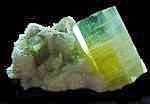
Mining Operations at Mount Mica & Orchard Pit Mines, Oxford County, Maine.
|
|
|
|
Mining Operations at Mount Mica & Orchard Pit Mines, Oxford County, Maine. |
|
Coromoto Minerals Mining
Operations at Mount Mica,
September-December, 2008 Page 2
|
2008 Oct-Dec Page 2 Our mining along this new drift had proven to be a setback for the ‘mined out faction’ (see page 1). As I write this in 2012, I
can say by means of 20/20 retrospection the pegmatite was definitely not mined out. True, the character of the pegmatite had changed as we worked our way eastward but the frequency of wonderments remained undiminished. Fascinating discoveries lie ahead of the work progressing in late 2008. I’ll attempt to continue to chronicle some of them here In all candor pocket MMP20-08 was not a gem producer. Candor is a rare commodity as we all know. True, it had interesting smoky quartz with pink quartz rings but, after that, it was a bust. 20 was in the Dagenais pocket class. The Dagenais was a huge pocket found in 1974. Except for a few beryls and some quartz crystals there was little in it. The tourmaline had suffered replacement. It was becoming more and more clear that we were indeed mining along the same trend that had produced the Dagenais. This line also produced the wonderful pocket of late 2004 (MMP28-04) that was very well endowed. The line is defined by a large fault in the country rock. The pegmatite thickens abruptly along this fault. This thickening is host to concentrations of Li and Cs at regular intervals along its east-west trend. Further along from 28-04 our huge pocket of 2005, MMP5-05, lay on this same trend. 5/5 was hybrid. Not as good as MMP28-04 in terms of tourmaline production but not has barren as the Dagenais or the most recent one, 20-08. In 20 we could plainly see the ‘should ofs’ and ‘could ofs’ in the form of gallons and gallons of epimorphs, casts, of mica after tourmaline. It seems if left to its own devices what tourmaline that develops in the pockets at Mt. Mica would like to eventually arrive at an endpoint in the form of muscovite. In the smaller pockets this process seems to be arrested before this disappointing outcome. Apparently 28-04 was just small enough to escape this destruction… if destruction is the correct term. Perhaps evolution is a better one. 28-04, as it turns out, was pristine. We opened it just a few weeks after starting to mine underground. We, sad to say, didn't appreciate the rarity of this pocket. Perhaps we will find another like it in the future and savor it more. As we advanced our drift eastward beyond 20-08, we soon
began to encounter massive Li minerals again. Fortunately for me it did not
require an especially keen intellect to conclude that soon we’d encounter yet
another large pocket. They seemed to be cropping up every 50’ or so along this fault. The notion was beginning take root that the rewards in terms of gem production along this trend wo
The images above show the similarity in structure and chemistry of the pegmatite at the fault visible at the portal and the area of 20-8. The 20-8 area is more than 140' from the portal; the structure appears the same. Moderately barren pegmatite near the vertical face of the fault abruptly concentrating Li/Cs minerals 2 meters away. This pattern continues to hold into current mining (2012-time machine again). As hinted above,the mining eastward in late November and into December started to show the first s
We would not begin to appreciate the magnitude of the space we had just encountered start until much later. We did not return to this area until 2011. The difficulties of mining at the lowest point in the mine in the dead of winter turned our January '09 mining up dip. This area, though a pocket, would better serve us as a temporary sump hole. In fact, in 2012 we would test the notion that better pockets lie down dip of the big ones (and up dip too).( In 2012 we'd mining just under Brian's feet but in the wall.) The lower ones we call the 'root'. This is based on the notion that the first areas to crystallize around a big space are down dip where the pegmatite at Mount Mica is thinner. Blue Sheppard , the operator of the Stewart Lithia Mine, refers to the up dip pockets as chimneys. If I have his notion right, the concept is the same I
|